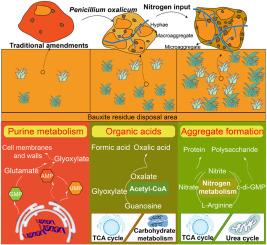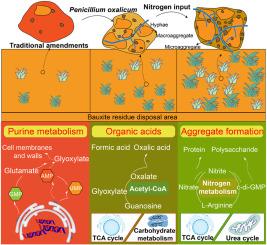Metabolism of Penicillium oxalicum-mediated microbial community reconstructed by nitrogen improves stable aggregates formation in bauxite residue: A field-scale demonstration
IF 10
1区 环境科学与生态学
Q1 ENGINEERING, ENVIRONMENTAL
引用次数: 0
Abstract
Microbially-driven stable aggregate formation plays a crucial role during the soil formation process in alkaline bauxite residue. However, the interacting mechanisms between microbial community assembly and aggregate formation remain poorly understood. In this study, we conducted a field-scale experiment and laboratory validations, coupled with multi-omics analysis, to investigate microbially-driven aggregate fraction turnover and its microbial driving mechanisms in bauxite residue. Field-based results demonstrated that Penicillium oxalicum (P. oxalicum) significantly increased the proportions of microaggregates (250-53 μm) and macroaggregates (>250 μm) by 20.98% and 22.19%, respectively. Moreover, nitrogen input was more strongly associated with the formation of microaggregates, increasing the proportion by 23.13% during the incubation. Microbial taxonomic analysis revealed that aggregate fraction turnover was regulated by functional trait-based community assembly and significantly correlated with Actinobacteria and Proteobacteria. Untargeted metabolomic analyses further confirmed that nitrogen input stimulated carbohydrate and nitrogen metabolism, with key metabolites (e.g., c-di-GMP, saccharopine, and arginine) involved in polysaccharide and protein biosynthesis, thus positively influencing aggregate formation. Furthermore, laboratory validations demonstrated that exogenous application of key metabolites significantly increased particle size and corrosion resistance. These findings highlighted the enhancement of nitrogen on P. oxalicum-mediated aggregate fraction turnover and advanced our understanding of microbially-driven soil formation processes in bauxite residue.


由草青霉介导的微生物群落的氮代谢重建改善了铝土矿残渣中稳定聚合体的形成:现场规模示范
在碱性铝土矿渣土壤形成过程中,微生物驱动的稳定团聚体形成起着至关重要的作用。然而,微生物群落组装和聚合体形成之间的相互作用机制仍然知之甚少。在本研究中,我们通过现场实验和实验室验证,结合多组学分析,探讨了铝土矿渣中微生物驱动的团聚体组分周转及其微生物驱动机制。田间试验结果表明,草酸青霉(P. oxalicum)显著提高了土壤微团聚体(250 ~ 53 μm)和大团聚体(>;250 μm),分别降低20.98%和22.19%。此外,氮输入与微团聚体形成的相关性更强,在培养期间增加了23.13%。微生物分类分析表明,总组分周转受基于功能性状的群落组装调控,与放线菌门和变形菌门具有显著相关性。非靶向代谢组学分析进一步证实,氮输入刺激了碳水化合物和氮的代谢,关键代谢物(如c-di-GMP、糖精和精氨酸)参与了多糖和蛋白质的生物合成,从而积极影响聚集体的形成。此外,实验室验证表明,外源应用的关键代谢物显著增加颗粒大小和耐腐蚀性。这些发现强调了氮对P. oxalicum介导的团聚体组分周转的增强作用,并促进了我们对铝土矿渣中微生物驱动的土壤形成过程的理解。
本文章由计算机程序翻译,如有差异,请以英文原文为准。
求助全文
约1分钟内获得全文
求助全文
来源期刊

Journal of Cleaner Production
环境科学-工程:环境
CiteScore
20.40
自引率
9.00%
发文量
4720
审稿时长
111 days
期刊介绍:
The Journal of Cleaner Production is an international, transdisciplinary journal that addresses and discusses theoretical and practical Cleaner Production, Environmental, and Sustainability issues. It aims to help societies become more sustainable by focusing on the concept of 'Cleaner Production', which aims at preventing waste production and increasing efficiencies in energy, water, resources, and human capital use. The journal serves as a platform for corporations, governments, education institutions, regions, and societies to engage in discussions and research related to Cleaner Production, environmental, and sustainability practices.
 求助内容:
求助内容: 应助结果提醒方式:
应助结果提醒方式:


